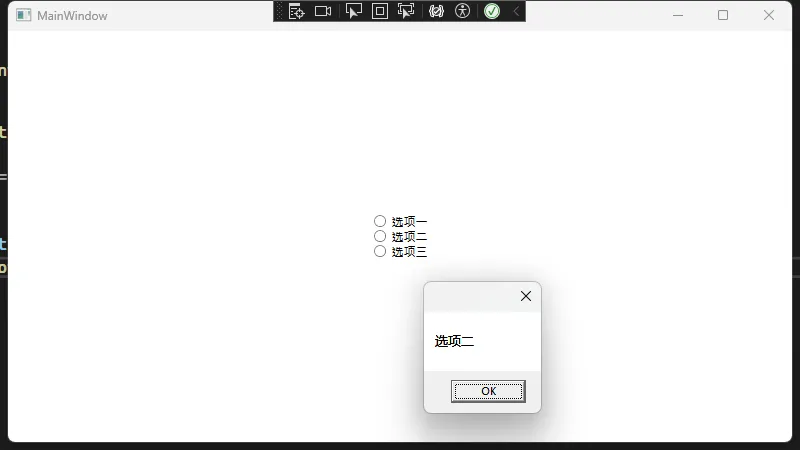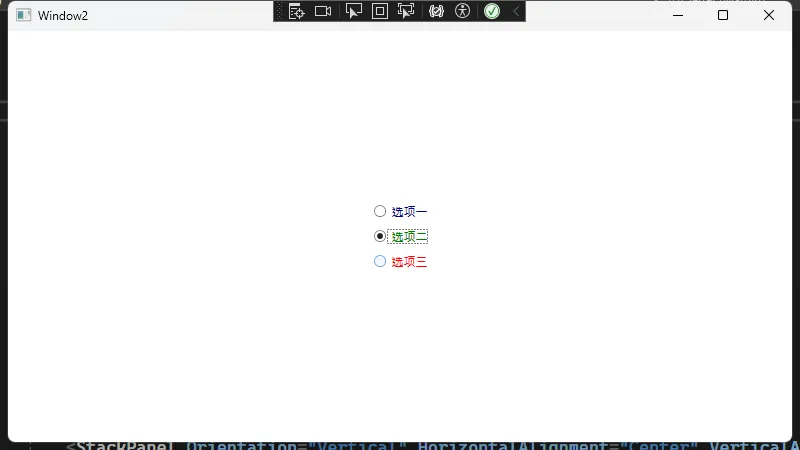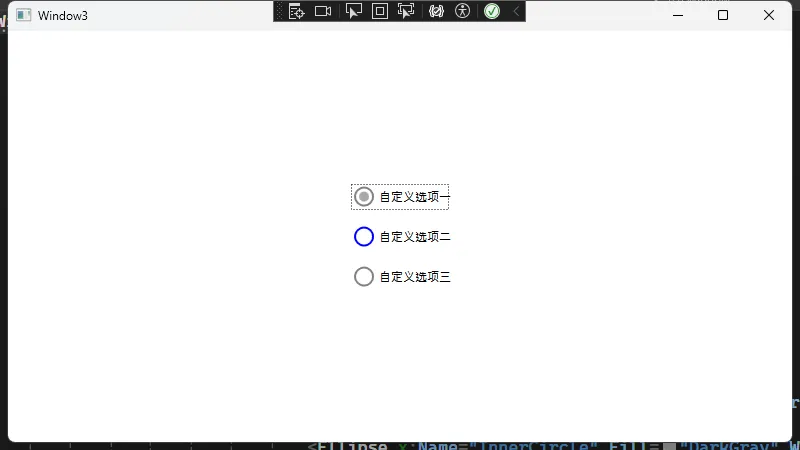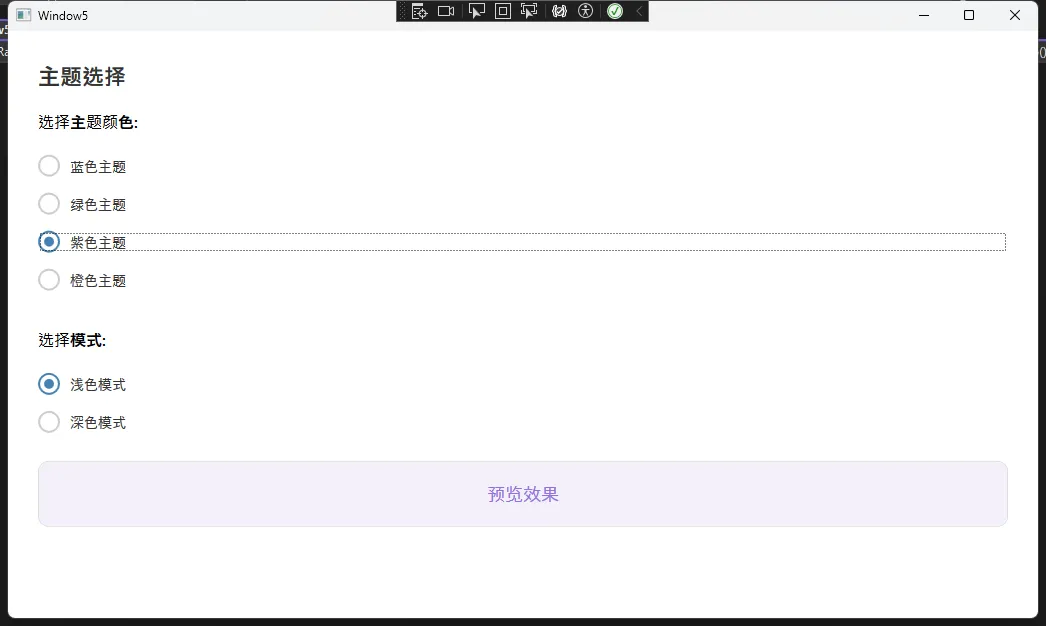目录
WinForm到WPF的转型往往让开发者需要适应新的组件和布局方式。本文将针对RadioButton在WPF下的使用,以及自定义样式的方式做较为详尽的介绍,并通过具体示例对比WinForm和WPF的实现与效果差异。
前言
在WinForm中,RadioButton是一种常用的选择控件。多组RadioButton可放置在相应的容器(例如GroupBox)中,或通过判断RadioButton的Checked属性进行选择。这些用法在WPF中也可以实现,但WPF的优势在于可直接通过XAML与数据绑定、样式和控件模板等特性进行更灵活的开发。
基本用法对比
在WinForm中的RadioButton
在WinForm中,如果要创建一个RadioButton,一般会这样写(以C#为例):
C#RadioButton rbtn1 = new RadioButton();
rbtn1.Text = "选项一";
// 设置位置
rbtn1.Location = new Point(20, 20);
// 事件处理
rbtn1.CheckedChanged += (s, e) =>
{
// 被选中时进行的处理
};
this.Controls.Add(rbtn1);
在WPF中的RadioButton
WPF中使用XAML可以轻松实现相同的效果。下面是一个最基础的写法:
XML<Window x:Class="AppRadioButton.MainWindow"
xmlns="http://schemas.microsoft.com/winfx/2006/xaml/presentation"
xmlns:x="http://schemas.microsoft.com/winfx/2006/xaml"
xmlns:d="http://schemas.microsoft.com/expression/blend/2008"
xmlns:mc="http://schemas.openxmlformats.org/markup-compatibility/2006"
xmlns:local="clr-namespace:AppRadioButton"
mc:Ignorable="d"
Title="MainWindow" Height="450" Width="800">
<Grid>
<StackPanel Orientation="Vertical" HorizontalAlignment="Center" VerticalAlignment="Center">
<RadioButton Content="选项一" x:Name="RadioButton1" Checked="RadioButton_Checked"/>
<RadioButton Content="选项二" x:Name="RadioButton2" Checked="RadioButton_Checked"/>
<RadioButton Content="选项三" x:Name="RadioButton3" Checked="RadioButton_Checked"/>
</StackPanel>
</Grid>
</Window>
在C#后端(MainWindow.xaml.cs)中捕获事件:
C#using System.Text;
using System.Windows;
using System.Windows.Controls;
using System.Windows.Data;
using System.Windows.Documents;
using System.Windows.Input;
using System.Windows.Media;
using System.Windows.Media.Imaging;
using System.Windows.Navigation;
using System.Windows.Shapes;
namespace AppRadioButton
{
/// <summary>
/// Interaction logic for MainWindow.xaml
/// </summary>
public partial class MainWindow : Window
{
public MainWindow()
{
InitializeComponent();
}
private void RadioButton_Checked(object sender, RoutedEventArgs e)
{
RadioButton rbtn = sender as RadioButton;
if (rbtn != null)
{
string content = rbtn.Content.ToString(); // 获取当前选项文字
MessageBox.Show(content);
}
}
}
}

RadioButton分组
无论在WinForm还是在WPF中,如果要区分多组RadioButton,需要将它们置于不同的容器内,例如GroupBox或Panel等。WPF中同样支持直接通过GroupName属性区分同一组内允许单选:
XML<Window x:Class="AppRadioButton.Window1"
xmlns="http://schemas.microsoft.com/winfx/2006/xaml/presentation"
xmlns:x="http://schemas.microsoft.com/winfx/2006/xaml"
xmlns:d="http://schemas.microsoft.com/expression/blend/2008"
xmlns:mc="http://schemas.openxmlformats.org/markup-compatibility/2006"
xmlns:local="clr-namespace:AppRadioButton"
mc:Ignorable="d"
Title="Window1" Height="450" Width="800">
<StackPanel Orientation="Vertical" Margin="10">
<GroupBox Header="分组一">
<StackPanel>
<RadioButton GroupName="GroupA" Content="选项一-A"/>
<RadioButton GroupName="GroupA" Content="选项二-A"/>
</StackPanel>
</GroupBox>
<GroupBox Header="分组二">
<StackPanel>
<RadioButton GroupName="GroupB" Content="选项一-B"/>
<RadioButton GroupName="GroupB" Content="选项二-B"/>
</StackPanel>
</GroupBox>
</StackPanel>
</Window>

自定义RadioButton样式
WPF强大之处在于可以自由定制控件的外观和交互动效。我们可以通过Style和ControlTemplate来自定义RadioButton的样式。
Style(简易样式示例)
下面的示例通过定义一个简单的Style来改变RadioButton的前景色和鼠标事件时的视觉反馈。
XML<Window x:Class="AppRadioButton.Window2"
xmlns="http://schemas.microsoft.com/winfx/2006/xaml/presentation"
xmlns:x="http://schemas.microsoft.com/winfx/2006/xaml"
xmlns:d="http://schemas.microsoft.com/expression/blend/2008"
xmlns:mc="http://schemas.openxmlformats.org/markup-compatibility/2006"
xmlns:local="clr-namespace:AppRadioButton"
mc:Ignorable="d"
Title="Window2" Height="450" Width="800">
<Window.Resources>
<!-- 简单的Style示例 -->
<Style TargetType="RadioButton" x:Key="ColorfulRadioButtonStyle">
<!-- 设置默认状态的样式 -->
<Setter Property="Foreground" Value="DarkBlue"/>
<Setter Property="Margin" Value="5"/>
<!-- 通过Trigger进一步定制 -->
<Style.Triggers>
<!-- 鼠标移入时改变前景色 -->
<Trigger Property="IsMouseOver" Value="True">
<Setter Property="Foreground" Value="Red"/>
</Trigger>
<!-- 当RadioButton被选中时 -->
<Trigger Property="IsChecked" Value="True">
<Setter Property="Foreground" Value="Green"/>
</Trigger>
</Style.Triggers>
</Style>
</Window.Resources>
<Grid>
<StackPanel Orientation="Vertical" HorizontalAlignment="Center" VerticalAlignment="Center">
<RadioButton Content="选项一" Style="{StaticResource ColorfulRadioButtonStyle}"/>
<RadioButton Content="选项二" Style="{StaticResource ColorfulRadioButtonStyle}"/>
<RadioButton Content="选项三" Style="{StaticResource ColorfulRadioButtonStyle}"/>
</StackPanel>
</Grid>
</Window>

在这个示例中,我们通过Trigger实现了MouseOver的前景色变化和被选中时的前景色变化。只要给需要的RadioButton赋予Style="{StaticResource ColorfulRadioButtonStyle}"即可。
ControlTemplate(整体外观定制示例)
以下示例展示了如何用ControlTemplate彻底重写RadioButton的外观,将传统的圆形选中样式改成一个自定义图标或形状:
XML<Window x:Class="AppRadioButton.Window3"
xmlns="http://schemas.microsoft.com/winfx/2006/xaml/presentation"
xmlns:x="http://schemas.microsoft.com/winfx/2006/xaml"
xmlns:d="http://schemas.microsoft.com/expression/blend/2008"
xmlns:mc="http://schemas.openxmlformats.org/markup-compatibility/2006"
xmlns:local="clr-namespace:AppRadioButton"
mc:Ignorable="d"
Title="Window3" Height="450" Width="800">
<Window.Resources>
<Style x:Key="CustomRadioButtonStyle" TargetType="RadioButton">
<Setter Property="Template">
<Setter.Value>
<ControlTemplate TargetType="RadioButton">
<StackPanel Orientation="Horizontal">
<!-- 自定义的“图标”容器 -->
<Grid Width="20" Height="20" Margin="5">
<!-- 未选中时的外观 -->
<Ellipse x:Name="OuterCircle" Stroke="Gray" StrokeThickness="2" Fill="White"/>
<!-- 选中时的外观 -->
<Ellipse x:Name="InnerCircle" Fill="DarkGray" Width="10" Height="10"
HorizontalAlignment="Center" VerticalAlignment="Center" Visibility="Hidden"/>
</Grid>
<!-- ContentPresenter用来呈现RadioButton上的文字 -->
<ContentPresenter VerticalAlignment="Center"/>
</StackPanel>
<!-- 通过Trigger控制选中的状态 -->
<ControlTemplate.Triggers>
<Trigger Property="IsChecked" Value="True">
<Setter TargetName="InnerCircle" Property="Visibility" Value="Visible"/>
</Trigger>
<!-- 鼠标移入视觉反馈 -->
<Trigger Property="IsMouseOver" Value="True">
<Setter TargetName="OuterCircle" Property="Stroke" Value="Blue"/>
</Trigger>
<!-- 不可用状态 -->
<Trigger Property="IsEnabled" Value="False">
<Setter TargetName="OuterCircle" Property="Stroke" Value="LightGray"/>
</Trigger>
</ControlTemplate.Triggers>
</ControlTemplate>
</Setter.Value>
</Setter>
</Style>
</Window.Resources>
<Grid>
<StackPanel Orientation="Vertical" HorizontalAlignment="Center" VerticalAlignment="Center">
<RadioButton Content="自定义选项一" Style="{StaticResource CustomRadioButtonStyle}" Margin="5"/>
<RadioButton Content="自定义选项二" Style="{StaticResource CustomRadioButtonStyle}" Margin="5"/>
<RadioButton Content="自定义选项三" Style="{StaticResource CustomRadioButtonStyle}" Margin="5"/>
</StackPanel>
</Grid>
</Window>

在这里,通过Grid+Ellipse的方式自定义了RadioButton的选中与未选中状态,并使用Trigger来决定哪些元素可见或改变样式。ContentPresenter负责显示RadioButton的文字部分。
数据绑定与MVVM
WPF最大的优势在于与MVVM(Model-View-ViewModel)模式结合,通过绑定来处理选中状态。例如下面的示例展示了如何绑定到ViewModel中的布尔值:
XML<Window x:Class="AppRadioButton.Window4"
xmlns="http://schemas.microsoft.com/winfx/2006/xaml/presentation"
xmlns:x="http://schemas.microsoft.com/winfx/2006/xaml"
xmlns:d="http://schemas.microsoft.com/expression/blend/2008"
xmlns:mc="http://schemas.openxmlformats.org/markup-compatibility/2006"
xmlns:local="clr-namespace:AppRadioButton"
mc:Ignorable="d"
Title="Window4" Height="450" Width="800">
<Grid>
<StackPanel Orientation="Vertical" HorizontalAlignment="Center" VerticalAlignment="Center">
<!-- 绑定到IsOptionASelected -->
<RadioButton Content="选项A"
IsChecked="{Binding IsOptionASelected, Mode=TwoWay, UpdateSourceTrigger=PropertyChanged}"
GroupName="SGroup"/>
<RadioButton Content="选项B"
IsChecked="{Binding IsOptionBSelected, Mode=TwoWay, UpdateSourceTrigger=PropertyChanged}"
GroupName="SGroup"/>
</StackPanel>
</Grid>
</Window>
后端ViewModel可类似如下定义:
C#using System;
using System.Collections.Generic;
using System.ComponentModel;
using System.Linq;
using System.Text;
using System.Threading.Tasks;
namespace AppRadioButton
{
public class MainViewModel : INotifyPropertyChanged
{
private bool _isOptionASelected;
public bool IsOptionASelected
{
get => _isOptionASelected;
set
{
_isOptionASelected = value;
OnPropertyChanged(nameof(IsOptionASelected));
if (value)
{
// 当选项A被选中时,可执行其他逻辑
IsOptionBSelected = false;
}
}
}
private bool _isOptionBSelected;
public bool IsOptionBSelected
{
get => _isOptionBSelected;
set
{
_isOptionBSelected = value;
OnPropertyChanged(nameof(IsOptionBSelected));
if (value)
{
// 当选项B被选中时,可执行其他逻辑
IsOptionASelected = false;
}
}
}
public event PropertyChangedEventHandler PropertyChanged;
private void OnPropertyChanged(string name)
{
PropertyChanged?.Invoke(this, new PropertyChangedEventArgs(name));
}
}
}
然后在应用程序启动时,将MainWindow的DataContext设置为这个MainViewModel实例即可:
C#public partial class MainWindow : Window
{
public MainWindow()
{
InitializeComponent();
this.DataContext = new MainViewModel();
}
}
这样,点击选择选项A或B会自动触发ViewModel属性的变更,并在界面自动更新。
一个示例
XML<Window x:Class="AppRadioButton.Window5"
xmlns="http://schemas.microsoft.com/winfx/2006/xaml/presentation"
xmlns:x="http://schemas.microsoft.com/winfx/2006/xaml"
xmlns:d="http://schemas.microsoft.com/expression/blend/2008"
xmlns:mc="http://schemas.openxmlformats.org/markup-compatibility/2006"
xmlns:local="clr-namespace:AppRadioButton"
mc:Ignorable="d"
Title="Window5" Height="450" Width="800">
<Window.Resources>
<!-- 自定义RadioButton样式 -->
<Style x:Key="ModernRadioButton" TargetType="{x:Type RadioButton}">
<Setter Property="Template">
<Setter.Value>
<ControlTemplate TargetType="{x:Type RadioButton}">
<Grid>
<Grid.ColumnDefinitions>
<ColumnDefinition Width="Auto"/>
<ColumnDefinition Width="*"/>
</Grid.ColumnDefinitions>
<Border x:Name="RadioBorder"
Width="22" Height="22"
CornerRadius="11"
BorderThickness="2"
BorderBrush="#CCCCCC"
Background="Transparent"
Margin="0,0,10,0">
<Ellipse x:Name="RadioMark"
Width="10" Height="10"
Fill="#4682B4"
Opacity="0"/>
</Border>
<ContentPresenter Grid.Column="1"
VerticalAlignment="Center"
HorizontalAlignment="Left"
Margin="0,1,0,0"/>
</Grid>
<ControlTemplate.Triggers>
<Trigger Property="IsMouseOver" Value="True">
<Setter TargetName="RadioBorder" Property="BorderBrush" Value="#4682B4"/>
</Trigger>
<Trigger Property="IsChecked" Value="True">
<Setter TargetName="RadioBorder" Property="BorderBrush" Value="#4682B4"/>
<Setter TargetName="RadioMark" Property="Opacity" Value="1"/>
</Trigger>
<Trigger Property="IsEnabled" Value="False">
<Setter TargetName="RadioBorder" Property="BorderBrush" Value="#DDDDDD"/>
<Setter TargetName="RadioMark" Property="Fill" Value="#DDDDDD"/>
</Trigger>
</ControlTemplate.Triggers>
</ControlTemplate>
</Setter.Value>
</Setter>
<Setter Property="Foreground" Value="#333333"/>
<Setter Property="FontSize" Value="14"/>
<Setter Property="Margin" Value="0,8,0,8"/>
<Setter Property="Cursor" Value="Hand"/>
</Style>
</Window.Resources>
<Grid Margin="30">
<Grid.RowDefinitions>
<RowDefinition Height="Auto"/>
<RowDefinition Height="Auto"/>
<RowDefinition Height="Auto"/>
<RowDefinition Height="Auto"/>
<RowDefinition Height="*"/>
</Grid.RowDefinitions>
<!-- 标题 -->
<TextBlock Grid.Row="0"
Text="主题选择"
FontSize="22"
FontWeight="SemiBold"
Foreground="#333333"
Margin="0,0,0,20"/>
<!-- 第一组RadioButton -->
<StackPanel Grid.Row="1" Margin="0,0,0,30">
<TextBlock Text="选择主题颜色:"
FontSize="16"
FontWeight="Medium"
Margin="0,0,0,15"/>
<RadioButton x:Name="rbBlue"
Content="蓝色主题"
GroupName="ThemeColor"
Style="{StaticResource ModernRadioButton}"
IsChecked="True"
Checked="ThemeRadioButton_Checked"/>
<RadioButton x:Name="rbGreen"
Content="绿色主题"
GroupName="ThemeColor"
Style="{StaticResource ModernRadioButton}"
Checked="ThemeRadioButton_Checked"/>
<RadioButton x:Name="rbPurple"
Content="紫色主题"
GroupName="ThemeColor"
Style="{StaticResource ModernRadioButton}"
Checked="ThemeRadioButton_Checked"/>
<RadioButton x:Name="rbOrange"
Content="橙色主题"
GroupName="ThemeColor"
Style="{StaticResource ModernRadioButton}"
Checked="ThemeRadioButton_Checked"/>
</StackPanel>
<!-- 第二组RadioButton -->
<StackPanel Grid.Row="2" Margin="0,0,0,20">
<TextBlock Text="选择模式:"
FontSize="16"
FontWeight="Medium"
Margin="0,0,0,15"/>
<RadioButton x:Name="rbLight"
Content="浅色模式"
GroupName="DisplayMode"
Style="{StaticResource ModernRadioButton}"
IsChecked="True"
Checked="ModeRadioButton_Checked"/>
<RadioButton x:Name="rbDark"
Content="深色模式"
GroupName="DisplayMode"
Style="{StaticResource ModernRadioButton}"
Checked="ModeRadioButton_Checked"/>
</StackPanel>
<!-- 预览面板 -->
<Border Grid.Row="3"
x:Name="previewPanel"
Background="#EDF5FF"
CornerRadius="10"
Padding="20"
BorderThickness="1"
BorderBrush="#DDDDDD">
<TextBlock Text="预览效果"
x:Name="previewText"
FontSize="18"
Foreground="#4682B4"
HorizontalAlignment="Center"/>
</Border>
</Grid>
</Window>
C#using System;
using System.Collections.Generic;
using System.Linq;
using System.Text;
using System.Threading.Tasks;
using System.Windows;
using System.Windows.Controls;
using System.Windows.Data;
using System.Windows.Documents;
using System.Windows.Input;
using System.Windows.Media;
using System.Windows.Media.Imaging;
using System.Windows.Shapes;
namespace AppRadioButton
{
/// <summary>
/// Interaction logic for Window5.xaml
/// </summary>
public partial class Window5 : Window
{
public Window5()
{
InitializeComponent();
UpdatePreview();
}
private void ThemeRadioButton_Checked(object sender, RoutedEventArgs e)
{
UpdatePreview();
}
private void ModeRadioButton_Checked(object sender, RoutedEventArgs e)
{
UpdatePreview();
}
private void UpdatePreview()
{
// 默认颜色 (蓝色主题)
Color themeColor = Color.FromRgb(70, 130, 180);
// 根据选择更改颜色
if (rbGreen != null && rbGreen.IsChecked == true)
themeColor = Color.FromRgb(60, 179, 113);
else if (rbPurple != null && rbPurple.IsChecked == true)
themeColor = Color.FromRgb(147, 112, 219);
else if (rbOrange != null && rbOrange.IsChecked == true)
themeColor = Color.FromRgb(255, 140, 0);
// 应用颜色到预览面板
if (previewText != null)
previewText.Foreground = new SolidColorBrush(themeColor);
// 应用模式(浅色/深色)
if (previewPanel != null)
{
if (rbLight != null && rbLight.IsChecked == true)
{
// 浅色模式
Color bgColor = Color.FromArgb(255,
(byte)(themeColor.R + (255 - themeColor.R) * 0.9),
(byte)(themeColor.G + (255 - themeColor.G) * 0.9),
(byte)(themeColor.B + (255 - themeColor.B) * 0.9));
previewPanel.Background = new SolidColorBrush(bgColor);
}
else
{
// 深色模式
Color bgColor = Color.FromArgb(255,
(byte)(themeColor.R * 0.2),
(byte)(themeColor.G * 0.2),
(byte)(themeColor.B * 0.2));
previewPanel.Background = new SolidColorBrush(bgColor);
previewText.Foreground = Brushes.White;
}
}
}
}
}

总结
从WinForm的RadioButton到WPF的RadioButton,开发者可以利用XAML和WPF独特的Style与ControlTemplate实现更丰富的界面效果。同时,借助MVVM方法可以轻松实现数据同步与状态管理,这些都是在WinForm中相对繁琐的部分。通过不断熟悉WPF的布局、样式和绑定机制,转型将变得更加顺畅。
本文作者:技术老小子
本文链接:
版权声明:本博客所有文章除特别声明外,均采用 BY-NC-SA 许可协议。转载请注明出处!